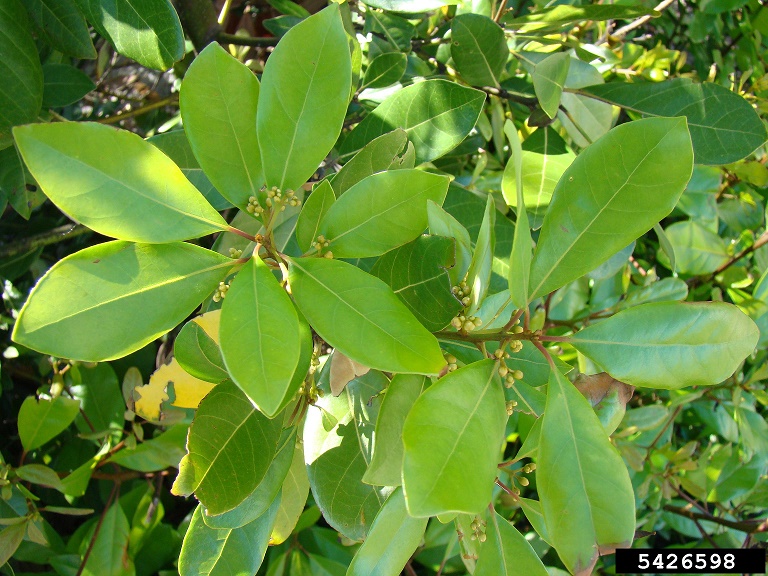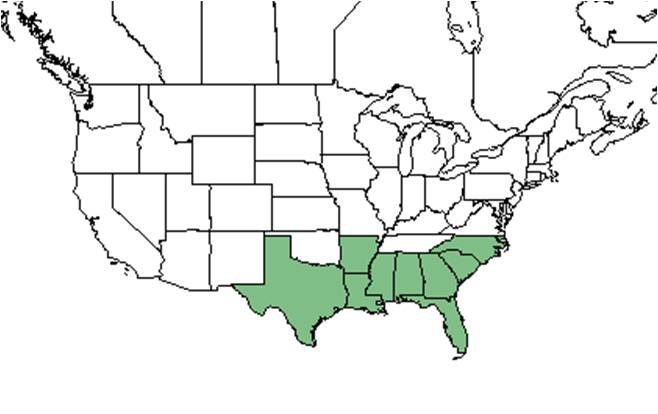Difference between revisions of "Persea borbonia"
KatieMccoy (talk | contribs) (→Distribution) |
KatieMccoy (talk | contribs) |
||
| Line 31: | Line 31: | ||
==Ecology== | ==Ecology== | ||
===Habitat=== <!--Natural communities, human disturbed habitats, topography, hydrology, soils, light, fire regime requirements for removal of competition, etc.--> | ===Habitat=== <!--Natural communities, human disturbed habitats, topography, hydrology, soils, light, fire regime requirements for removal of competition, etc.--> | ||
| − | In the Coastal Plain in Florida, ''P. borbonia'' has been observed in cabbage palm-live oak hammocks, pine/scrub oak communities, mixed hardwood forests, vegetated shell mounds, tropical evergreen hardwood forests, dune thickets, oak-hickory-magnolia coastal hammocks, and wet pine flatwoods. It has been found in disturbed areas such as bulldozed turkey oak/longleaf pine communities and roadsides (FSU Herbarium). | + | In the Coastal Plain in Florida, ''P. borbonia'' has been observed in cabbage palm-live oak hammocks, pine/scrub oak communities, mixed hardwood forests, vegetated shell mounds, tropical evergreen hardwood forests, dune thickets, oak-hickory-magnolia coastal hammocks, and wet pine flatwoods. It has been found in disturbed areas such as bulldozed turkey oak/longleaf pine communities and roadsides (FSU Herbarium). Redbay requires partial to fun sun, plenty of water supply, and root oxygen<ref name="warnell"/>. It does not tolerate long periods of inundation(Conner and George 1993). Soils are mostly Histosols <ref name="fs">[[http://www.na.fs.fed.us/pubs/silvics_manual/volume_2/persea/borbonia.htm]]Accessed: February 19, 2016</ref>. It grows in loamy sand, sandy loam, and limestone substrate. Associated species include ''Gordonia lasianthus, Quercus geminata, Celtis, Exothea paniculata, Xanthoxylum, Fagara, Persea littoralis, Rapanea guianensis, Parthenocissus quinquefolia, Plumbago scandens, Bumelia, Forestiera, Rhizophora, Baccharis halimifolia'', black cherry and hackberry (FSU Herbarium). |
===Phenology=== <!--Timing off flowering, fruiting, seed dispersal, and environmental triggers. Cite PanFlora website if appropriate: http://www.gilnelson.com/PanFlora/ --> | ===Phenology=== <!--Timing off flowering, fruiting, seed dispersal, and environmental triggers. Cite PanFlora website if appropriate: http://www.gilnelson.com/PanFlora/ --> | ||
Revision as of 19:05, 17 February 2016
| Persea borbonia | |
|---|---|

| |
| Photo by Rebekah D. Wallace, University of Georgia Bugwood.org | |
| Scientific classification | |
| Kingdom: | Plantae |
| Division: | Magnoliophyta - Flowering plants |
| Class: | Magnoliopsida – Dicotyledons |
| Order: | Laurales |
| Family: | Lauraceae |
| Genus: | Persea |
| Species: | P. borbonia |
| Binomial name | |
| Persea borbonia (L.) Spreng. | |

| |
| Natural range of Persea borbonia from USDA NRCS Plants Database. | |
Common name: redbay
Contents
Taxonomic notes
This species has had many scientific names since its discovery. The genus name Persea is derived from a Greek term for a Persian tree with fruits growing from the stem[1].
Description
A description of Persea borbonia is provided in The Flora of North America.
Distribution
The native distribution of redbay includes the Coastal Plain from south Delaware to Florida, west to southeast Texas, with isolated populations in central Texas[2].
Ecology
Habitat
In the Coastal Plain in Florida, P. borbonia has been observed in cabbage palm-live oak hammocks, pine/scrub oak communities, mixed hardwood forests, vegetated shell mounds, tropical evergreen hardwood forests, dune thickets, oak-hickory-magnolia coastal hammocks, and wet pine flatwoods. It has been found in disturbed areas such as bulldozed turkey oak/longleaf pine communities and roadsides (FSU Herbarium). Redbay requires partial to fun sun, plenty of water supply, and root oxygen[1]. It does not tolerate long periods of inundation(Conner and George 1993). Soils are mostly Histosols [3]. It grows in loamy sand, sandy loam, and limestone substrate. Associated species include Gordonia lasianthus, Quercus geminata, Celtis, Exothea paniculata, Xanthoxylum, Fagara, Persea littoralis, Rapanea guianensis, Parthenocissus quinquefolia, Plumbago scandens, Bumelia, Forestiera, Rhizophora, Baccharis halimifolia, black cherry and hackberry (FSU Herbarium).
Phenology
P. borbonia has been observed flowering April through May and fruiting January through July (FSU Herbarium).
Seed dispersal
Seed bank and germination
Fire ecology
Pollination
The following Hymenoptera families and species were observed visiting flowers of Persea borbonia at Archbold Biological Station (Deyrup 2015):
Apidae: Apis mellifera, Bombus impatiens, Epeolus zonatus
Colletidae: Colletes banksi, C. brimleyi, C. nudus
Halictidae: Augochlora pura, Augochloropsis metallica, Lasioglossum pectoralis
Sphecidae: Cerceris fumipennis, Tachytes auricomans
Vespidae: Mischocyttarus cubensis, Pachodynerus erynnis, Parancistrocerus salcularis rufulus, Polistes metricus, Zethus spinipes
Use by animals
Diseases and parasites
Conservation and Management
Cultivation and restoration
Photo Gallery
References and notes
Deyrup, M.A. and N.D. 2015. Database of observations of Hymenoptera visitations to flowers of plants on Archbold Biological Station, Florida, USA.
Florida State University Robert K. Godfrey Herbarium database. URL: http://herbarium.bio.fsu.edu. Last accessed: October 2015. Collectors: Loran C. Anderson, Delzie Demaree, R.J. Eaton, J.P. Gillespie, Robert K. Godfrey, Bruce Hansen, R. Komarek, Robert Kral, H. Kurz, O. Lakela, Elbert L. Little Jr., Sidney McDaniel, K.M. Meyer, Richard S. Mitchell, T. Myint, Jackie Patman, Elmer C. Prichard, Gwynn W. Ramsey, James D. Ray Jr., G. Robertson, Cecil R. Slaughter, Annie Schmidt, C.E. Smith, R.R. Smith, R.F. Thorne, A. Townesmith, Rodie White, C.E. Wood, Jean W. Wooten, Richard P. Wunderlin. States and Counties: Florida: Alachua, Brevard, Calhoun, Citrus, Columbia, Dade, Dixie, Flagler, Franklin, Gadsden, Jackson, Jefferson, Lee, Leon, Levy, Liberty, Marion, Martin, Nassau, Okaloosa, Osceola, Pasco, Pinellas, Suwannee, St. Johns, St. Lucie, Taylor, Volusia, Wakulla, Walton. Georgia: Grady. Compiled by Tall Timbers Research Station and Land Conservancy.